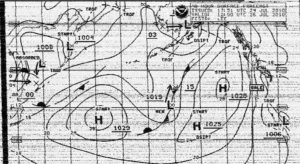As I write this we have around 1500 miles left. There is no real news this week, we’ve been slowly sailing north, northeast, and east depending on the wind. We’ve been close to becalmed twice and are motoring as we speak. When the boat is doing 4.3 knots and the wind instruments are showing 5 knots of wind on the nose, there isn’t enough wind to go much of anywhere. It’s actually been a pretty boring week all things considered.
What makes this passage different from all our other passages is the weather. Most everything else was tradewind sailing in pretty settled weather. Worst you’d see is a front or two passing. Up here in the north Pacific the wind is generated around a series of lows and highs. We spend all our time watching the weather trying to stay between lows and highs, under the illusion we can dodge and weave our way across the ocean in favorable winds. The truth is we are at the mercy of weather systems that don’t follow forecasts. At no point in this passage do we get to say, “We’re home free now, it’s all downhill from here”, at least not until we enter the breakwater at Port Angeles in a couple of weeks. After the passage is over we may say, “That was a pretty nice sail, over all!” but during the passage we can never feel that relaxed about the weather to come. I think this is the most tiring aspect of this passage.
 We download up to 24 weather faxes per day from the NOAA service out of Hawaii. There are 1, 2, 3, and 4 day forecasts, Surface Analysis faxes that give us current locations of all weather systems, and Wind/Wave forecasts that tell us what to expect in 2 and 4 days. Most are done in 12 hour intervals, some cover different sections of the ocean. Additionally we request spot forecasts from a service of boat email, Sailmail. We send in a series of locations and it returns a three day wind/wave forecast in three hour increments. These are especially worthwhile in preparing the boat for the winds in the next 12 hours or so. If it’s going to pipe up to 20 knots in the middle of the night, we can ensure the boat is set up for that night’s winds before it gets dark. This strategy has kept middle-of-the-night fire drills to a minimum. Between our weather faxes and spot forecasts via Sailmail, we get a pretty clear picture of the weather, and what to expect.
We download up to 24 weather faxes per day from the NOAA service out of Hawaii. There are 1, 2, 3, and 4 day forecasts, Surface Analysis faxes that give us current locations of all weather systems, and Wind/Wave forecasts that tell us what to expect in 2 and 4 days. Most are done in 12 hour intervals, some cover different sections of the ocean. Additionally we request spot forecasts from a service of boat email, Sailmail. We send in a series of locations and it returns a three day wind/wave forecast in three hour increments. These are especially worthwhile in preparing the boat for the winds in the next 12 hours or so. If it’s going to pipe up to 20 knots in the middle of the night, we can ensure the boat is set up for that night’s winds before it gets dark. This strategy has kept middle-of-the-night fire drills to a minimum. Between our weather faxes and spot forecasts via Sailmail, we get a pretty clear picture of the weather, and what to expect.
 It helps to have a sense of humor, especially when it comes to weather forecasts. As Teresa reported, our 4-day forecasts from NOAA are the worst case, cover-our-bureaucratic-asses sort of forecast. Of course, I shouldn’t say this until we’re behind that breakwater in Port Angeles or we’ll see one of these 4-day wonders actually come true.
It helps to have a sense of humor, especially when it comes to weather forecasts. As Teresa reported, our 4-day forecasts from NOAA are the worst case, cover-our-bureaucratic-asses sort of forecast. Of course, I shouldn’t say this until we’re behind that breakwater in Port Angeles or we’ll see one of these 4-day wonders actually come true.
Today is the first day we’ve had the boat in gear in over a week. We have 67 gallons of diesel left, about half of our original amount with less than one third of the trip left. We’ve seen so little sun this passage that the solar panels and wind generator have had a hard time keeping up with our electrical usage. You’d think we’d be home free with a broken refrigerator but we still use a lot of amps with all the electronics and laptops. Did you know a laptop consumes nearly as much as our refer did? Add to that all the SSB radio time (30 amps when broadcasting) and fax receiving times (average 12 minutes per fax, during which a laptop, SSB, and Modem are all powered up) and it’s rare to see less than 12 amps out of the batteries at any given time. Between the Honda generator and the main engine we charge almost every day.
We’ve made 780 gallons of fresh water, our water tanks are currently full since we fill up with the water maker anytime we are motoring. We aren’t fishing. We lost a great lure to something way too big. Before ducking into Adak, Red Thread reported losing lures also and having difficulty landing the large tuna that were striking. Between losing lures and the cold we just don’t think it’s worth sitting out in the cold watching a couple of hand lines on the off-chance of catching a tuna. No hard core fishermen here.
Today on Yohelah we are bored, and strangely hoping to stay that way.
Rob